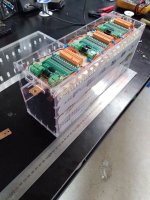BlueSeas
100 W
I'm building a Bomber clone with a QS205 V3 50H motor. Initial controller 150A Sabvoton. Have been researching what battery to use for this build. Not terribly worried about range, but want minimum 100A from the battery at 72V nominal.
I've only really found 2 options:
1) Standard answer, a spot welded 18650 pack. Probably 6P or better, 20S.
2) Non standard answer Headway 40152S cells 24S.
My first build used Vruzend and Panasonic cells. I was satisfied. Bluetooth BMS monitoring of cells has shown the pack completely in sync. At rest and under load. 20S 3P delivered 50A intermittent. However, after finishing the build, I determined the time to disassemble and replace a faulty cell would take so much time, I might as well build a new pack. It's even worse, if you use a normal pack and don't do your own spot welding.
But that's a bit of a roll of the dice? Labor wise anyway.
So that got me looking at alternatives. Pouch cells too complicated to interconnect. Prismatic square cells a possibility. Previous experience in marine applications demonstrated at least one brand didn't like being set on their side. Not sure if this is universal, but the BMS manufacturer said they had heard of similar problems.
So that leaves cylindrical cells. In 15-17 Ah, that seems to leave the market to Headway?
I read through all I could find here and other places on Headway cells, including the DrBass thread from 2006-2008. I understand the LiFePo4 chemistry, requires more cells 24 vs 20 for 72V. And the power density is less, requiring more space...and weight tolerance for similar capacity packs. Hard to make work for a triangle pack on a "normal" bike frame. But the 15-17 Ah 40152 cells fit fine in my enduro frame. I'd like to run 2P with the 38120HP cells, but can't make that fit easily.
So...the questions:
1) Is there any other drawbacks to the Headway cells vs. the other choices I missed?
2) Are the 20 or 25 Ah prismatic cells being used anywhere? Realistic max current intermittent?
3) Is there some other option I've overlooked? The Headway solution is 10 years old now...
Thanks!
I've only really found 2 options:
1) Standard answer, a spot welded 18650 pack. Probably 6P or better, 20S.
2) Non standard answer Headway 40152S cells 24S.
My first build used Vruzend and Panasonic cells. I was satisfied. Bluetooth BMS monitoring of cells has shown the pack completely in sync. At rest and under load. 20S 3P delivered 50A intermittent. However, after finishing the build, I determined the time to disassemble and replace a faulty cell would take so much time, I might as well build a new pack. It's even worse, if you use a normal pack and don't do your own spot welding.
But that's a bit of a roll of the dice? Labor wise anyway.
So that got me looking at alternatives. Pouch cells too complicated to interconnect. Prismatic square cells a possibility. Previous experience in marine applications demonstrated at least one brand didn't like being set on their side. Not sure if this is universal, but the BMS manufacturer said they had heard of similar problems.
So that leaves cylindrical cells. In 15-17 Ah, that seems to leave the market to Headway?
I read through all I could find here and other places on Headway cells, including the DrBass thread from 2006-2008. I understand the LiFePo4 chemistry, requires more cells 24 vs 20 for 72V. And the power density is less, requiring more space...and weight tolerance for similar capacity packs. Hard to make work for a triangle pack on a "normal" bike frame. But the 15-17 Ah 40152 cells fit fine in my enduro frame. I'd like to run 2P with the 38120HP cells, but can't make that fit easily.
So...the questions:
1) Is there any other drawbacks to the Headway cells vs. the other choices I missed?
2) Are the 20 or 25 Ah prismatic cells being used anywhere? Realistic max current intermittent?
3) Is there some other option I've overlooked? The Headway solution is 10 years old now...
Thanks!


